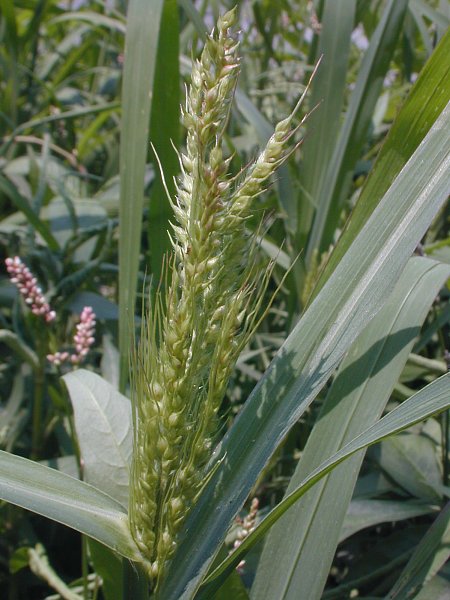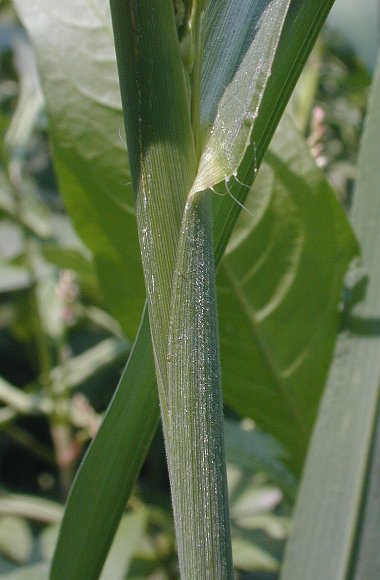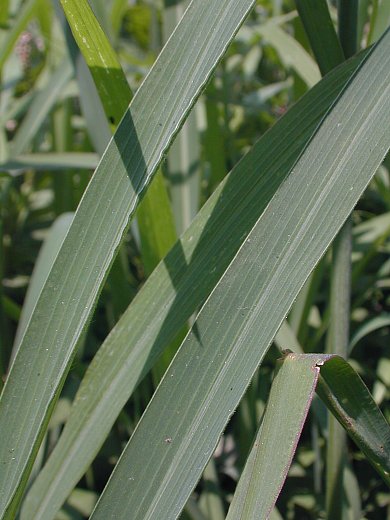Description: This grass is a summer annual about 1½–3½' tall. An individual plant often branches at the base, sending up multiple culms that can sprawl or stand erect; each of these culms is unbranched. The culms are light green, terete, and glabrous. The blades of the alternate leaves are up to 16" long and ¾" across; they are green or blue-green, linear in shape, rather floppy, and usually hairless. Sometimes a leaf blade may have a few long hairs near its base. The leaf sheaths are the same color as the blades and usually hairless; however, some sheaths have short fine hairs. Each culm terminates in a panicle of spikelets up to 10" long. The branches of this panicle are up to 2½" long; they spread outward as the panicle matures. The spikelets are arranged on one-side of each branch; they are densely distributed along its length. The spikelets are light green to dark green and more or less covered with fine hairs; sometimes they become purple or dark red in bright sunlight. Each spikelet consists of 2 glumes, 2 lemmas, and a floret; it is ovoid in shape and about 3-4 mm. long (excluding any awn). The first glume is about 1/3 the length of the spikelet, while the second glume and infertile lemma form the exterior of the spikelet. In this variety of Barnyard Grass, the infertile lemmas usually have awns about 3-10 mm. long; less often, they have awns up to 25 mm. (1") long. The fertile lemma is hidden from view behind the awnless second glume; it encloses the floret on one side, which has 2 feathery stigmas, 3 stamens, and an ovary.

The
blooming period can occur from mid-summer to early fall. The florets
are wind-pollinated. Each spikelet produces a single grain that is
about 3 mm. long, ovoid, and somewhat flattened. The root system is
shallow and fibrous. This grass spreads by reseeding itself, and it
often forms colonies at favorable sites.
Cultivation:
The preference is full to partial sun, wet to moist conditions, and
fertile soil that is loamy or silty. The seeds germinate after the
weather is warm and settled.
Range & Habitat:
The native Awned Barnyard Grass occurs in every county of Illinois and
it is quite
common (see Distribution
Map). Habitats include openings in floodplain woodlands,
swamps, marshes, low areas along ponds and rivers, ditches, cropland,
abandoned fields, low areas in vacant lots, gardens, and moist waste
areas. This grass prefers degraded wetlands or disturbed areas with
exposed fertile ground.

Faunal
Associations:
Various insects feed on the foliage and other parts of Barnyard Grass
(Echinochloa muricata).
These species include Chaetocnema
denticulata
(Toothed Flea Beetle) and Chaetocnema
pulicaria (Corn Flea Beetle),
larvae of the leafminer flies, Agromyza
parvicornis (Corn Blotch
Leafminer) and Cerodontha
dorsalis (Grass Sheath Miner), larvae of the
gall fly, Calamomyia
echinochloa (Grass Crown Midge), larvae of Lerema
accius (Clouded Skipper), and Phoetaliotes nebrascensis
(Large-headed
Grasshopper); see Clark et al. (2004), Needham et al. (1928), Felt
(1917), Bouseman et al. (2006), and Brust et al. (2008). Such aphids as
Anoecia setariae
(Foxtail Root Aphid), Hysteroneura
setariae (Rusty
Plum Aphid), Rhopalosiphum
maidis (Corn Leaf Aphid), Schizaphis
graminum (Greenbug), and Tetraneura nigriabdominalis
(Rice Root Aphid)
suck sap from this grass (Blackman & Eastop, 2013; Robinson
&
Bradley, 1965). The seeds are an important source of food to many
species of
birds, especially dabbling ducks (see Bird Table).
The Prairie Deer Mouse and wild House Mouse also eat the seeds
(Whitaker, 1966).
Cattle and other mammalian herbivores readily graze on Barnyard Grass,
but the
high nitrates in the foliage can cause bloat if it is eaten in
quantity. When dense
colonies of this grass occur in wetland areas, it provides cover for
wetland birds and other kinds of wildlife.
Photographic Location:
A roadside ditch near Urbana, Illinois.

Comments: Awned Barnyard Grass is considered a common weed in agricultural fields and around gardens, but it is deliberately cultivated in wetland areas by some wildlife managers as a source of food for ducks. Barnyard Grasses (Echinochloa spp.) have an unstable taxonomic history. In addition to Echinochloa muricata muricata, other scientific names that are applied to Awned Barnyard Grass include Echinochloa crus-galli and Echinochloa pungens pungens. Some authorities make a distinction between native Barnyard Grass (Echinochlora muricata, Echinochlora pungens) and introduced Barnyard Grass from Eurasia (Echinochloa crus-galli). However, the morphological differences between these two groups of grasses are quite small. According to Mohlenbrock (1973/2001), the introduced Barnyard Grass has a fertile lemma with a fragile tip and a ring of small hairs at the base of this tip. In contrast, the fertile lemma of native Barnyard Grass has a firm flexible tip that lacks this ring of hairs. Unfortunately, the fertile lemma is hidden from view by the second glume in a spikelet of Barnyard Grass. Once these two structures are pried apart, a good hand-lens is required to observe the key characteristics of the fertile lemma. Another species that occurs in Illinois, Echinochloa walteri, has a more bristly appearance than the Barnyard Grasses that have been described thus far. This is because both the second glumes and infertile lemmas of its spikelets are awned, and these awns are usually longer than those of other Barnyard Grasses in Illinois, which lack glumes with awns.